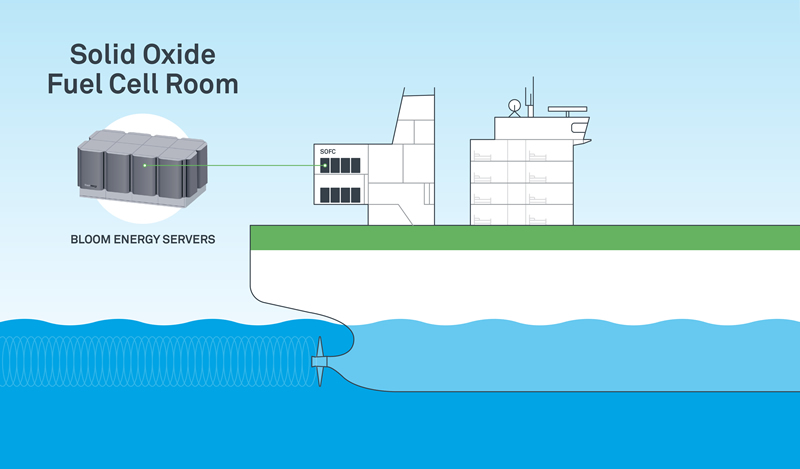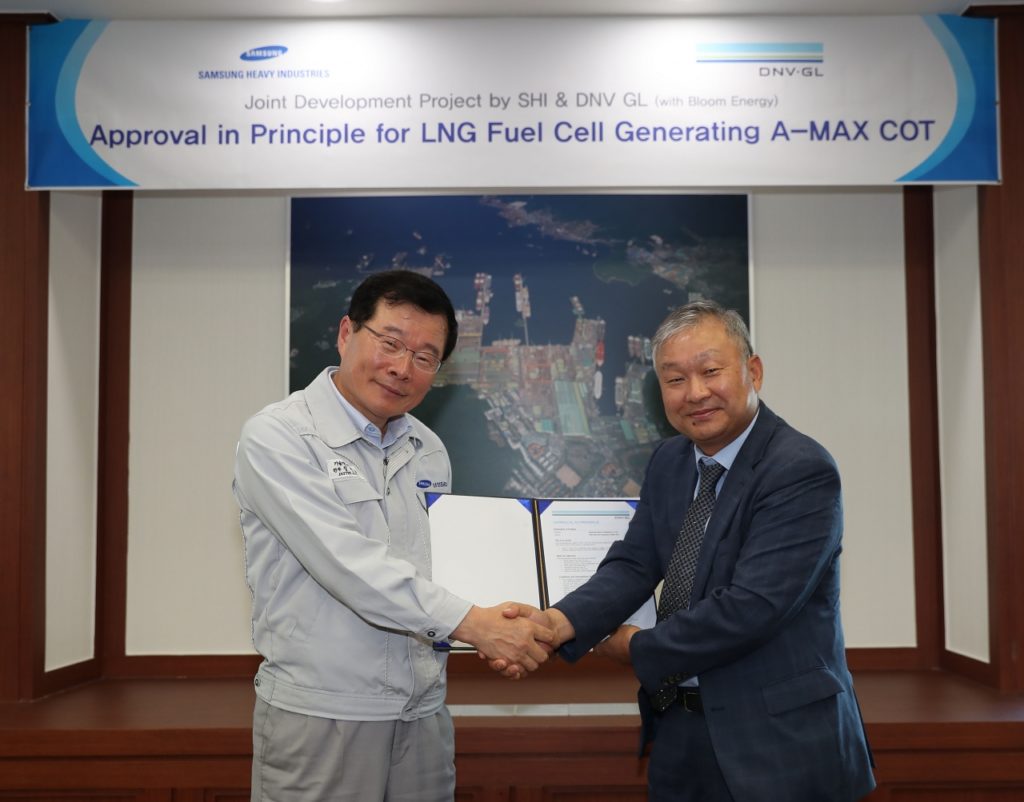
- Replacing Oil-based Power Generation with Fuel Cells Could Reduce Greenhouse Gas Emissions from Marine Transport by 45%
SAN JOSE, Calif.–Bloom Energy and Samsung Heavy Industries (SHI), a part of Samsung Group, today announced a collaboration to design and develop ships powered by Bloom Energy’s solid oxide fuel cell technology. Bloom Energy is the world’s leading provider of stationary fuel cells and SHI is one of the world’s largest shipbuilding companies.
 SHI aims to be the first shipbuilder to deliver a large cargo ship for ocean operation powered by fuel cells running on natural gas. Such an innovation will play a key role in helping the company exceed the 50 percent emissions reduction target, compared to 2008 levels, that the International Maritime Organization (IMO) has mandated all shipbuilders should achieve by 2050. The IMO, an arm of the United Nations, is the global standard-setting agency for the safety, security, and environmental performance of international shipping.
SHI aims to be the first shipbuilder to deliver a large cargo ship for ocean operation powered by fuel cells running on natural gas. Such an innovation will play a key role in helping the company exceed the 50 percent emissions reduction target, compared to 2008 levels, that the International Maritime Organization (IMO) has mandated all shipbuilders should achieve by 2050. The IMO, an arm of the United Nations, is the global standard-setting agency for the safety, security, and environmental performance of international shipping.
The two companies have already taken an important first step towards commercializing the maritime use of fuel cells for propulsion and auxiliary power. At a ceremony in the SHI Geoje shipyard, Samsung Heavy Industries announced they have received Approval in Principle from DNV GL, the internationally accredited marine shipping registrar and classification society, in collaboration with Bloom Energy to proceed with a fuel cell-powered ship design for Aframax crude oil tankers (COTs).
“As regulations to reduce GHG emissions take effect step-by-step, the introduction of fuel cells to vessels is inevitable. This approval, and being the first shipbuilder to secure this marine fuel cell technology, illustrates that Samsung Heavy is highly likely to lead the market,” said Kyunghee Kim, vice president of SHI Outfitting Engineering Team.
“It is a meaningful GHG emissions reduction measure to apply Bloom Energy’s fuel cell system to SHI’s new Aframax design. SHI’s new Aframax design is equipped with a new generating system in combination of the conventional, generator engines, and the new fuel cell technology, both fueled with LNG,” said Hwa Lyong Lee, vice president of Regional Business Development, Maritime at DNV GL. “This innovative design is one of the ways to improve GHG emissions, to further make LNG a solid and long-term solution.”
Today, 80 percent of the world’s shipping fleet runs on heavy fuel oil, or bunker fuel. The combustion of this fuel to provide propulsion and auxiliary power to ships causes the marine transport industry to produce between 2% and 3% of global carbon emissions. If the global marine shipping industry was a country, it would be the sixth largest producer of greenhouse gas (GHG) emissions in the world.
Replacing combustion-based power generation from bunker oil with electrochemical conversion of liquid natural gas (LNG) through fuel cells could have a profound impact on carbon emissions from marine transportation. Bloom Energy and SHI estimate that replacing oil-based power generation on large cargo ships, which require up to 100 megawatts of power per ship, could reduce annual greenhouse gas emissions from shipping by 45 percent.
Combustion of bunker fuel also emits sulfur and particulate matter that causes respiratory illness. A 2018 study found that health impacts due to pollution from shipping include 14 million cases of childhood asthma annually and 400,000 premature deaths a year from lung cancer and cardiovascular disease.
“Bloom Energy has already helped companies around the world reduce their carbon emissions by more than four billion pounds of CO2,” said KR Sridhar, founder, chairman and CEO of Bloom Energy. “Bringing the Bloom Energy Server’s transformative clean technology to the shipping industry provides us with a tremendously exciting opportunity to accelerate the decarbonization of another vital sector of the global economy.”
In contrast to bunker fuel combustion, Bloom Energy solid oxide fuel cells generate electric power through an electrochemical reaction, without combustion, that virtually eliminates particulate emissions, NOx, and SOx – an important consideration for the shipping industry.
Bloom Energy Servers use natural gas, biogas or hydrogen as fuel. Bloom Energy and SHI envision onboard fuel cells being powered by natural gas, converted from liquefied natural gas (LNG), which is already commonly transported by marine shipping worldwide.
The modularity of Bloom Energy Servers makes them well suited to the space constraints of ships. Unlike large, multi-megawatt generating combustion engines, Bloom Energy Servers can be deployed in increments as small as 200 kilowatts, enabling power sources to be distributed throughout a ship to optimize space utilization. SHI envisions Bloom Energy Servers displacing existing power generation sets, and therefore requiring no additional space, or even reducing the total space required for power generation.
Bloom Energy Servers have been deployed hundreds of times on land including on-site at commercial and industrial businesses, counting 25 of the Fortune 100 companies. The same technology has been approved by DNV GL to be deployed aboard ships with minor modifications to suit ship installation and use in an enclosed environment.
Bloom Energy recently announced the capability of its fuel cells to run on hydrogen. As nations and ports develop their hydrogen infrastructure, fuel cell-powered ships could transition from natural gas fuel to hydrogen fuel and become zero-carbon and zero-smog emitters.
Cautionary Note Regarding Forward-Looking Statements:
Certain information contained in this release is forward-looking information within the meaning of the “safe harbor” provisions of the U.S. Private Securities Litigation Reform Act of 1995. Forward-looking information includes, among other things, statements concerning the planned fuel cell project.
The following factors, in addition to those discussed in Bloom Energy’s Annual Report on Form 10-K for the year ended December 31, 2018, and subsequent securities filings, and Bloom Energy Corporation’s Quarterly Report on Form 10-Q for the quarter ended June 30, 2019 and subsequent filings with the Securities and Exchange Commission, could cause actual results to differ materially from each company’s expectations as suggested by such forward-looking information: the ability to develop the fuel cell capable for marine transport; development cost or schedule delays; changes or proposed changes in applicable laws, regulations, permits or other requirements of marine operations The information in this press release is as of September 21, 2019. Bloom Energy Corporation expressly disclaim any obligation to update any forward-looking information, except as required by law.
About Bloom Energy
Bloom Energy’s mission is to make clean, reliable, and affordable energy for everyone in the world. The Company’s product, the Bloom Energy Server, delivers highly reliable and resilient, ‘Always-On’ electric power that is clean and sustainable. Bloom’s customers include 25 of the Fortune 100 companies and leaders in cloud services and data centers, healthcare, retail, financial services, utilities and many other industries. For more information, visit www.bloomenergy.com
Read the most up to date Fuel Cell and Hydrogen Industry news at FuelCellsWorks




